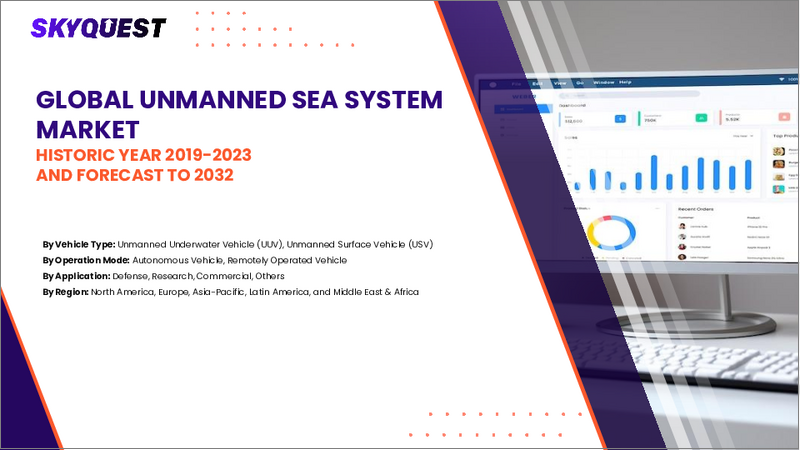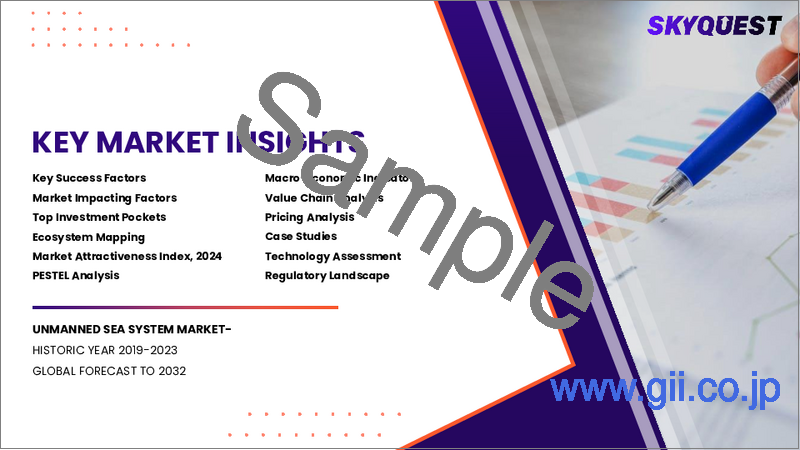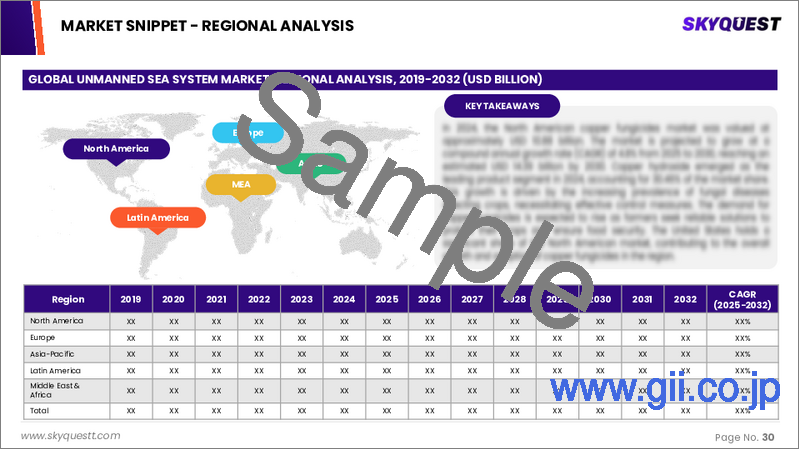|
|
市場調査レポート
商品コード
1777294
無人海上システム市場規模、シェア、成長分析、タイプ別、能力別、用途別、地域別 - 産業予測、2025年~2032年Unmanned Sea System Market Size, Share, and Growth Analysis, By Type (Unmanned Underwater Vehicles, Unmanned Surface Vehicles ), By Capability, By Application, By Region - Industry Forecast 2025-2032 |
||||||
|
|||||||
| 無人海上システム市場規模、シェア、成長分析、タイプ別、能力別、用途別、地域別 - 産業予測、2025年~2032年 |
|
出版日: 2025年07月21日
発行: SkyQuest
ページ情報: 英文 171 Pages
納期: 3~5営業日
|
全表示
- 概要
- 目次
無人海上システムの世界市場規模は2023年に28億米ドルと評価され、2024年の31億6,000万米ドルから2032年には82億8,000万米ドルに成長し、予測期間(2025-2032年)のCAGRは12.8%で成長する見通しです。
無人海上システムの世界市場は、ナビゲーションと自律的意思決定を強化する人工知能(AI)の進歩に後押しされて力強い成長を遂げています。この技術進歩により、困難な水中環境の安全な探査が可能になる一方、船隊のアップグレードや水中マッピング構想の拡大が、特に欧州と北米での数量増加を促進しています。さらに、アジア太平洋地域の国々は、海底情報と海底ルートマッピングのために自律型海中ロボット(AUV)を戦略的に取得しています。さらに、バッテリー技術、水中通信システム、低騒音推進装置への多額の投資が、市場の安定性と成長性を強化しています。情勢は、技術革新と戦略的配備の収束によって特徴付けられ、世界の海上無人能力の継続的な進歩の舞台となっています。
目次
イントロダクション
- 調査の目的
- 調査範囲
- 定義
調査手法
- 情報調達
- 二次と一次データの方法
- 市場規模予測
- 市場の前提条件と制限
エグゼクティブサマリー
- 世界市場の見通し
- 供給と需要の動向分析
- セグメント別機会分析
市場力学と見通し
- 市場概要
- 市場規模
- 市場力学
- 促進要因と機会
- 抑制要因と課題
- ポーターの分析
主な市場の考察
- 重要成功要因
- 競合の程度
- 主な投資機会
- 市場エコシステム
- 市場の魅力指数(2024年)
- PESTEL分析
- マクロ経済指標
- バリューチェーン分析
- 価格分析
- ケーススタディ
無人海上システム市場規模:タイプ別& CAGR(2025-2032)
- 市場概要
- 無人水中車両(UUV)
- 無人水上車両(USV)
無人海上システム市場規模:能力別& CAGR(2025-2032)
- 市場概要
- 遠隔操作車両
- 自動運転車
無人海上システム市場規模:用途別& CAGR(2025-2032)
- 市場概要
- 軍隊用
- 商業用
- その他の用途
無人海上システム市場規模:地域別& CAGR(2025-2032)
- 北米
- 米国
- カナダ
- 欧州
- ドイツ
- スペイン
- フランス
- 英国
- イタリア
- その他欧州地域
- アジア太平洋地域
- 中国
- インド
- 日本
- 韓国
- その他アジア太平洋地域
- ラテンアメリカ
- ブラジル
- その他ラテンアメリカ地域
- 中東・アフリカ
- GCC諸国
- 南アフリカ
- その他中東・アフリカ
競合情報
- 上位5社の比較
- 主要企業の市場ポジショニング(2024年)
- 主な市場企業が採用した戦略
- 最近の市場動向
- 企業の市場シェア分析(2024年)
- 主要企業の企業プロファイル
- 企業の詳細
- 製品ポートフォリオ分析
- 企業のセグメント別シェア分析
- 収益の前年比比較(2022-2024年)
主要企業プロファイル
- Atlas Elektronik
- BAE Systems
- General Dynamics
- Lockheed Martin
- Thales
- Teledyne Technologies
- Balt Robotics
- Boeing Company
- L3Harris Technologies Inc.
- Boston Engineering Corporation
- Gate Elektronik
- Kongsberg
結論と提言
Global Unmanned Sea System Market size was valued at USD 2.8 billion in 2023 and is poised to grow from USD 3.16 billion in 2024 to USD 8.28 billion by 2032, growing at a CAGR of 12.8% during the forecast period (2025-2032).
The global market for unmanned sea systems is experiencing robust growth fueled by advancements in artificial intelligence (AI) that enhance navigation and autonomous decision-making. This technological progression enables safer exploration of challenging underwater environments, while fleet upgrades and expanding underwater mapping initiatives are driving volume increases, particularly in Europe and North America. Additionally, nations in the Asia-Pacific region are strategically acquiring Autonomous Underwater Vehicles (AUVs) for seabed intelligence and submarine route mapping. Furthermore, significant investments in battery technology, underwater communication systems, and low-noise propulsion are reinforcing the market's stability and growth potential. The landscape is marked by a convergence of innovation and strategic deployments, setting the stage for continued advancements in unmanned maritime capabilities globally.
Top-down and bottom-up approaches were used to estimate and validate the size of the Global Unmanned Sea System market and to estimate the size of various other dependent submarkets. The research methodology used to estimate the market size includes the following details: The key players in the market were identified through secondary research, and their market shares in the respective regions were determined through primary and secondary research. This entire procedure includes the study of the annual and financial reports of the top market players and extensive interviews for key insights from industry leaders such as CEOs, VPs, directors, and marketing executives. All percentage shares split, and breakdowns were determined using secondary sources and verified through Primary sources. All possible parameters that affect the markets covered in this research study have been accounted for, viewed in extensive detail, verified through primary research, and analyzed to get the final quantitative and qualitative data.
Global Unmanned Sea System Market Segments Analysis
Global Unmanned Sea System Market is segmented by Type, Capability, Application and region. Based on Type, the market is segmented into Unmanned Underwater Vehicles (UUV) and Unmanned Surface Vehicles (USV). Based on Capability, the market is segmented into Remotely Operated Vehicles and Autonomous Vehicles. Based on Application, the market is segmented into Military, Commercial and Other Applications. Based on region, the market is segmented into North America, Europe, Asia Pacific, Latin America and Middle East & Africa.
Driver of the Global Unmanned Sea System Market
The Global Unmanned Sea System market is being significantly driven by an increase in defense spending among various countries seeking to enhance their unmanned maritime capabilities. This surge is largely attributed to the demand for force multiplication and cost-effective Intelligence Surveillance and Reconnaissance (ISR) solutions, which has led to a heightened procurement of Autonomous Underwater Vehicles (AUVs) and Unmanned Surface Vehicles (USVs). Collaborative initiatives among nations, particularly those in Asia-Pacific and Europe, are fostering advancements in AI-based navigation and long-endurance mission modules. As a result, autonomous sea platforms are becoming essential strategic assets in defense, aligning with evolving geopolitical demands for enhanced operational readiness and surveillance capabilities.
Restraints in the Global Unmanned Sea System Market
One of the key market restraints for the global unmanned sea system market is the regulatory challenges associated with maritime operations. Compliance with international maritime laws, safety regulations, and environmental protections poses significant hurdles for developers and operators of unmanned sea systems. The lack of standardized regulations across different jurisdictions can lead to uncertainties and increased operational costs. Furthermore, the need for permits and adherence to stringent guidelines can slow down innovation and deployment of these technologies. As nations grapple with emerging maritime security concerns and environmental impacts, navigating this complex regulatory landscape remains a crucial challenge for market participants.
Market Trends of the Global Unmanned Sea System Market
The Global Unmanned Sea System market is witnessing a transformative trend as artificial intelligence (AI) increasingly drives autonomy in naval operations. By 2024, AI-operated unmanned maritime systems are redefining mission protocols through autonomous route-following, real-time threat detection, and onboard decision-making, moving beyond traditional hard-coded algorithms. Industry leaders like L3Harris and Elbit Systems are integrating adaptive autonomy in their latest vessel designs, enabling enhanced underwater and surface operations without human intervention. This pivotal shift highlights the growing demand for advanced, intelligent unmanned systems, positioning AI as a critical catalyst in the evolution of naval strategy and operational capabilities within the maritime defense sector.
Table of Contents
Introduction
- Objectives of the Study
- Scope of the Report
- Definitions
Research Methodology
- Information Procurement
- Secondary & Primary Data Methods
- Market Size Estimation
- Market Assumptions & Limitations
Executive Summary
- Global Market Outlook
- Supply & Demand Trend Analysis
- Segmental Opportunity Analysis
Market Dynamics & Outlook
- Market Overview
- Market Size
- Market Dynamics
- Drivers & Opportunities
- Restraints & Challenges
- Porters Analysis
- Competitive rivalry
- Threat of substitute
- Bargaining power of buyers
- Threat of new entrants
- Bargaining power of suppliers
Key Market Insights
- Key Success Factors
- Degree of Competition
- Top Investment Pockets
- Market Ecosystem
- Market Attractiveness Index, 2024
- PESTEL Analysis
- Macro-Economic Indicators
- Value Chain Analysis
- Pricing Analysis
- Case Studies
Global Unmanned Sea System Market Size by Type & CAGR (2025-2032)
- Market Overview
- Unmanned Underwater Vehicles (UUV)
- Unmanned Surface Vehicles (USV)
Global Unmanned Sea System Market Size by Capability & CAGR (2025-2032)
- Market Overview
- Remotely Operated Vehicles
- Autonomous Vehicles
Global Unmanned Sea System Market Size by Application & CAGR (2025-2032)
- Market Overview
- Military
- Commercial
- Other Applications
Global Unmanned Sea System Market Size & CAGR (2025-2032)
- North America (Type, Capability, Application)
- US
- Canada
- Europe (Type, Capability, Application)
- Germany
- Spain
- France
- UK
- Italy
- Rest of Europe
- Asia Pacific (Type, Capability, Application)
- China
- India
- Japan
- South Korea
- Rest of Asia-Pacific
- Latin America (Type, Capability, Application)
- Brazil
- Rest of Latin America
- Middle East & Africa (Type, Capability, Application)
- GCC Countries
- South Africa
- Rest of Middle East & Africa
Competitive Intelligence
- Top 5 Player Comparison
- Market Positioning of Key Players, 2024
- Strategies Adopted by Key Market Players
- Recent Developments in the Market
- Company Market Share Analysis, 2024
- Company Profiles of All Key Players
- Company Details
- Product Portfolio Analysis
- Company's Segmental Share Analysis
- Revenue Y-O-Y Comparison (2022-2024)
Key Company Profiles
- Atlas Elektronik
- Company Overview
- Business Segment Overview
- Financial Updates
- Key Developments
- BAE Systems
- Company Overview
- Business Segment Overview
- Financial Updates
- Key Developments
- General Dynamics
- Company Overview
- Business Segment Overview
- Financial Updates
- Key Developments
- Lockheed Martin
- Company Overview
- Business Segment Overview
- Financial Updates
- Key Developments
- Thales
- Company Overview
- Business Segment Overview
- Financial Updates
- Key Developments
- Teledyne Technologies
- Company Overview
- Business Segment Overview
- Financial Updates
- Key Developments
- Balt Robotics
- Company Overview
- Business Segment Overview
- Financial Updates
- Key Developments
- Boeing Company
- Company Overview
- Business Segment Overview
- Financial Updates
- Key Developments
- L3Harris Technologies Inc.
- Company Overview
- Business Segment Overview
- Financial Updates
- Key Developments
- Boston Engineering Corporation
- Company Overview
- Business Segment Overview
- Financial Updates
- Key Developments
- Gate Elektronik
- Company Overview
- Business Segment Overview
- Financial Updates
- Key Developments
- Kongsberg
- Company Overview
- Business Segment Overview
- Financial Updates
- Key Developments





